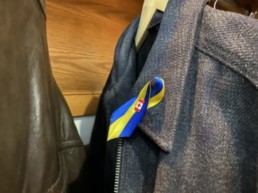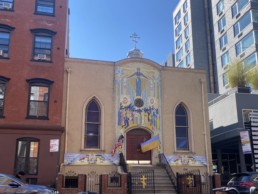Edmonton Church Rallies for Ukraine
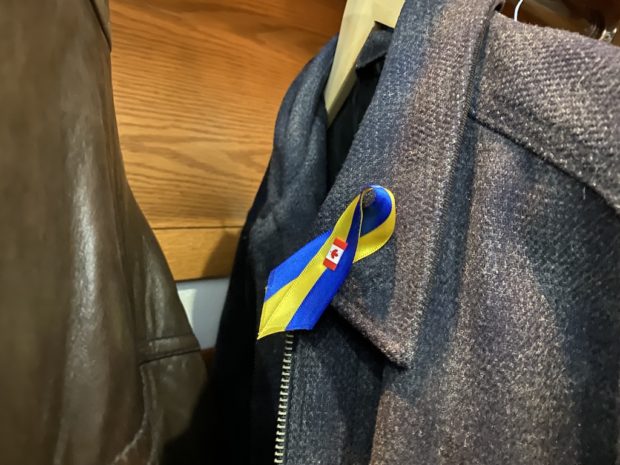
Listen to audio story: Edmonton Church Rallies for Ukraine
Click here for audio story transcript
(Originally aired April 28, 2022)
How I Got This Story:
On my flight into Edmonton, I sat next to a Canadian photographer returning home from a trip to Europe. He’d visited Poland and Ukraine, taking pictures of refugees at the border between the two countries. As we flew over the snow-covered plains of Alberta, he looked out the window and said, “Yep, this is what Poland looks like.”
I was heading to Edmonton to find out how Ukrainian-Canadians there are responding to the current war in Ukraine, and how they’re welcoming the new arrivals who’ve fled the violence. I knew, on a surface level, that Eastern Europe and Western Canada can both get bitterly cold, but it hadn’t occurred to me that the two places, halfway around the world from each other, might actually look similar from the sky.
In fact, as I learned from historian Jans Balan, director of the Kule Ukrainian Canadian Studies Centre at the University of Alberta, the Canadian government actively recruited Ukrainians to come and farm the cold Canadian prairie in the late 19th century. Canada even instituted a law similar to the United States’s Homestead Act — if settlers would come and cultivate a piece of land, then they could have it. Because of similarities in weather and topography, Ukrainians could grow the same crops in Canada as they’d grown back home. It was a natural fit.
Many Ukrainians took the opportunity, and today there are Ukrainian communities in Canada that go back four or five generations. Outside Ukraine and Russia, Canada is home to the largest population of Ukrainians in the world.
Though the current war in Ukraine is entering its third month, the United States did not announce a formal plan to admit people fleeing Ukraine until late April. Canada, on the other hand, began granting three-year residence to Ukrainians in mid-March.
My beat for the Covering Religion seminar is Orthodox Christianity. Since Russia’s assault on Ukraine began soon after our class started, I’ve focused on New York’s Ukrainian Orthodox churches, reporting on one on the Upper West Side and one in the East Village. New York has the largest Ukrainian population in the United States, but Ukrainians here are not nearly as visible as they are in some towns and cities in Canada.
More than 100,000 Ukrainians live in Edmonton, making up more than 10 percent of the city’s population. In 1983, the Edmonton Ukrainian community created the world’s first-ever monument to the Holodomor, a famine that killed millions of Ukrainians under Joseph Stalin 50 years earlier. The monument stands outside Edmonton’s City Hall, not far from another one dedicated to Alberta’s Ukrainian pioneer women. This other statue — the bronze “Madonna of the Wheat” by sculptor John Weaver — wears her hair atop her head in a traditional Ukrainian braid.
Many of the city’s Ukrainians attend one of five Ukrainian Orthodox churches. (Some instead attend St. Barbara’s Russian Orthodox Cathedral, which was founded by Russian Orthodox missionaries to serve Edmonton’s Ukrainian community in 1902, though I learned that some St. Barbara’s members, wanting to distance themselves from the Russians, have been visiting Ukrainian churches since the war started.)
The largest of Edmonton’s Ukrainian Orthodox churches is St. John’s Ukrainian Orthodox Cathedral. The Rev. Cornell Zubritsky, a priest at St. John’s, was my primary contact. I found his phone number on the cathedral’s website, and he told me he’s a member of a committee assembled by the Ukrainian Orthodox Church of Canada to coordinate the national church’s response to the war. (Zubritsky grew up north of Edmonton, in the town of Vegreville, where, he said, even non-Ukrainians speak with slight Slavic accents.)
Zubritsky was the one who told me about the airport welcome booth the Edmonton Ukrainian community has organized to welcome refugees from the war. He himself has taken shifts at the booth, and many others who attend the cathedral have, too.
When I got to the airport, I sat at the welcome booth for about an hour. (No one arrived from Ukraine, so I talked with Svitlana Fizer, who was staffing the booth, and she taught me the Cyrillic alphabet.)
The next day, I interviewed Zubristky and attended a welcome event for newly-arrived Ukrainians at the Ukrainian National Federation building. I met one young boy, Artom Yershov, who’d recently fled Ukraine with his parents. When I asked him whether he hopes to return to Ukraine someday, he said no. “I want to live in Edmonton, Canada,” he said.
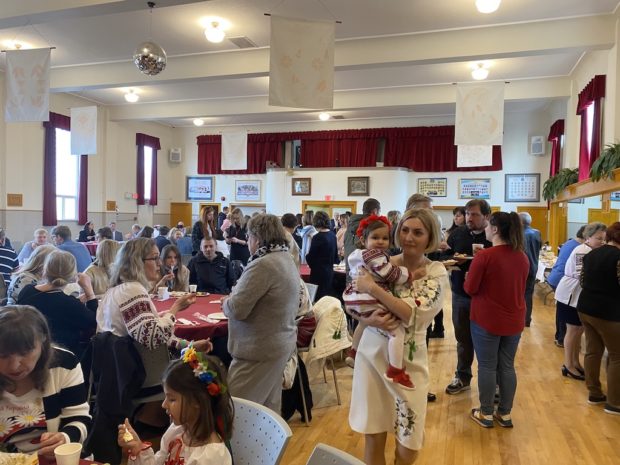
On Palm Sunday, I went to the service at St. John’s Cathedral and heard Zubristky preach a sermon about Jesus accompanying the community in their difficult time through the suffering of his passion during Holy Week.
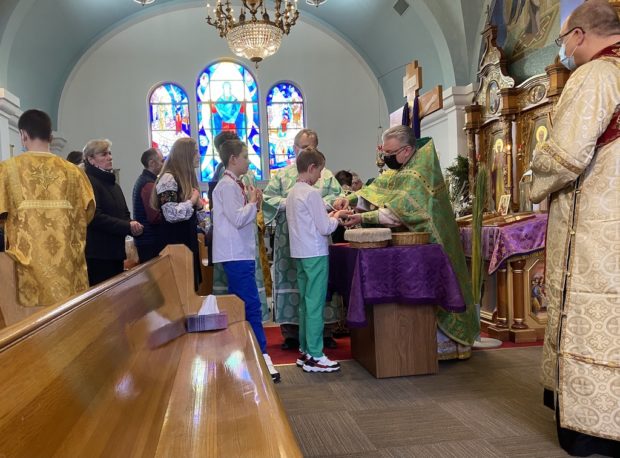
Late Sunday night, I sat at the airport welcome booth until 1:00am, waiting for arrivals from Ukraine. More than 300 have come since the war began, and many have joined relatives already established in Edmonton. But some have arrived at the airport without a plan, and without anyone to pick them up. The welcome booth volunteers have driven new arrivals to the Edmonton Inn, which is offering them free temporary accommodation, and then quickly matched them with volunteer host families.

Iryna Polishchuk is in-between these two situations. In Ukraine, she was an elementary school English teacher. Her daughter lives in Vancouver. When Russia started bombing Ukraine, she was about to return home to Ukraine from a vacation in Greece. Her daughter, who lives in Vancouver, called her to tell her she must not return to Ukraine, but should come to Canada instead. Polishchuk flew to Vancouver, with only what she’d packed for Greece — no coat, no boots. (The weather in Edmonton is still quite cold at this time of year. It snowed twice while I was there.)
Polishchuk stayed in Vancouver for several weeks, but she and her daughter ultimately decided it would be best for her to go instead to Edmonton, more than 700 miles away. Since the Ukrainian community is bigger in Edmonton, she’d have a better chance there of finding a job. Polishchuk’s daughter’s long-distance partner lives in Edmonton, so she is staying with him while she looks for work. In the meantime, Ivan Lypovyk’s brother gave her a ride to a welcome event for Ukrainians at the Ukrainian National Federation building, and a woman she met on the Facebook page for Ukrainians in Edmonton offered to take her to the mall to help her find a coat. She’ll need one, as other Ukrainians who’ve arrived in Edmonton before here have found, but she’ll also have a warm community to sustain her.
Anxious East Village Community Prays for Relatives Back Home in Ukraine
Among the worshipers at All Saints Ukrainian Orthodox Church in Manhattan on Sunday, Tetiana Geletei prayed fervently for her father.
Geletei’s whole family is in Ukraine, where her father has been called by the Ukrainian army to fight the Russian invasion. “I cannot connect to him,” she said. “I don’t know where he is now. Is he safe?” Her pitch rose as she voiced her last worry: “If he has something to eat at all.”
At the service, Pastor Vitaliy Pavlykivsky urged congregants to pray for Ukraine and to donate money to support the Ukrainian army. The church is located at 206 East 11th Street in the East Village.
A flier on a table near the prayer candles for sale at the church’s entrance listed a bank account and routing number for donations. “Ukrainian National Federal Credit Union has open account: ‘Help Ukraine’ for the Armed forces of Ukraine. Collected funds will be wired every day to support Ukraine,” it read.
At the end of the formal part of the service, when Pavlykivsky had blessed each of the worshippers individually, Iryna Rusyn, 22, asked where she could donate money to support the army. She’d brought cash with her.
Rusyn had spent more than an hour traveling to the church by train from Queens, she told me outside afterwards. She doesn’t have time to make the journey every Sunday. In fact, she’d only been to All Saints once before. But she needed to be there this week.
“I felt that I needed to pray for my country, for my people,” she said on the church steps, hands stuffed into the pockets of her long black faux fur coat. Despite the cold, she’d made plans to meet up with a friend, a fellow Ukrainian, to go to a rally in support of their homeland.
After she had left, most people still lingered in the church. “Because of this event, of course they pray a bit longer now,” she explained.
Inside, children ran from side to side along the back aisle and bounded up and down the stairs to the balcony where some of their mothers were singing in the choir. Four kids wore the colors of the Ukrainian flag, which flew outside the church door.
The mood among the adults was somber and anxious. One woman wiped her eyes repeatedly during prayers. She hastily stepped outside twice to take calls on her cell phone, pressing it to her ear before she’d even reached the door.
Geletei, 30, a human resources coordinator, is here in the United States by herself. She described the how church’s atmosphere felt changed: “It’s different because people are hurt.”
The president of the church, Oleh Mykulynskyy, had left New York for Ukraine that morning, Geletei said.
“He served [the] Ukrainian army before he came to the United States. So he felt like he needs to go back and try to help,” Geletei said.
As the whole church prayed for Mykulynskyy, his wife sang upstairs with the choir, as she does every Sunday.
“When we found out that he left, half of the choir was crying,” Geletei said.
Rusyn was not the only person who came to support the church community because of the ongoing crisis. Pavlykivsky greeted a small group of Georgians in English and thanked them for their prayers and support, and a young woman named Samantha whose grandparents had belonged to the church after they had immigrated from Ukraine visited for the first time. But for members, being together was emotionally intense.
“It’s really hard to be here. It’s really hard,” Geletei said. “Because, you know, you can feel the pain.”
“Praying helps,” Geletei said. “And all this long prayer at the end, it was specifically regarding the war. So we were praying for stopping the war, we were praying for strength for Ukrainians.”

